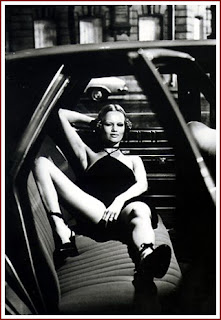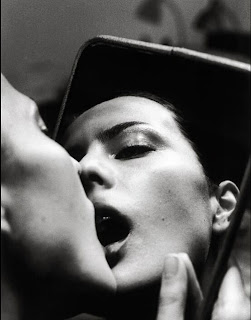
Helmut Newton, born Helmut Neustädter (October 31, 1920, Berlin, Germany – January 23, 2004, West Hollywood, California, USA) was a German-Australian photographer. He was a "prolific, widely imitated fashion photographer whose provocative, erotically charged black-and-white photos were a mainstay of Vogue and other publications.
Born in Berlin to a German-Jewish button-factory owner and an American mother, Newton attended the Heinrich-von-Treitschke-Realgymnasium and the American School in Berlin. Interested in photography from the age of 12 when he purchased his first camera, he worked for the


German photographer Yva (Elsie Neulander Simon) from 1936. The increasingly oppressive restrictions placed on Jews by the Nuremberg laws meant that his father lost control of the factory in which he manufactured buttons and buckles; he was briefly interned in a concentration camp, 'Kristallnacht,' which on November 9, 1938, compelled the family to leave Germany. Newton's parents fled to Chile. He was issued with a passport just after turning 18, and left Germany on December 5, 1938. At Trieste he boarded the 'Conte Rosso' (along with about 200 others escaping the Nazis) intending to journey to China. After arriving in Singapore he decided to remain as a reporter for the Straits Times and worked as a portrait photographer.


Newton was interned by British authorities while in Singapore, and was sent to Australia on board the Queen Mary, arriving in Sydney on September 27, 1940. Internees travelled to the camp of Tatura, Victoria by train under armed guard. He was released from internment in 1942, and briefly worked as a fruit picker in northern Victoria. In April 1942, he enlisted with the Australian Army and worked as a truck driver. After the war in 1945, he became an Australian citizen and changed his name to Newton in 1946. In 1948, he married actress June Browne, who performed under the stage name June Brunell. She later became a successful photographer under the ironic pseudonym Alice Springs (after Alice Springs, the central Australian town)
 Newton's growing reputation as a fashion photographer was rewarded when he secured a commission to illustrate fashions in a special Australian supplement for Vogue magazine, published in January 1956. He won a 12-month contract with British Vogue and left for London in February 1957, leaving Talbot to manage the business. Newton left the magazine before the end of his contract and went to Paris, where he worked for French and German magazines. He returned to Melbourne in March 1959 to a contract for Australian Vogue.
Newton's growing reputation as a fashion photographer was rewarded when he secured a commission to illustrate fashions in a special Australian supplement for Vogue magazine, published in January 1956. He won a 12-month contract with British Vogue and left for London in February 1957, leaving Talbot to manage the business. Newton left the magazine before the end of his contract and went to Paris, where he worked for French and German magazines. He returned to Melbourne in March 1959 to a contract for Australian Vogue.Newton settled in Paris in 1961 and continued work as a fashion photographer. His works appeared in magazines including, most significantly, French Vogue and Harper's Bazaar. He established a particular style marked by erotic, stylized scenes, often with sado-masochistic and fetishistic subtexts. A heart attack in 1970 slowed Newton's output, but his notoriety continued to increase, most notably with his 1980 "Big Nudes" series, which marked the pinnacle of his erotic-urban style, underpinned with excellent technical skills. Newton also worked in portraiture and more fantastical studies.
 Newton shot a number of pictorials for Playboy, including pictorials of Nastassia Kinski and Kristine DeBell . Original prints of the photographs from his August 1976 pictorial of DeBell, "200 Motels, or How I Spent My Summer Vacation" were sold at auctions of Playboy archives by Bonhams in 2002 for $21,075, and by Christies in December 2003 for $26,290
Newton shot a number of pictorials for Playboy, including pictorials of Nastassia Kinski and Kristine DeBell . Original prints of the photographs from his August 1976 pictorial of DeBell, "200 Motels, or How I Spent My Summer Vacation" were sold at auctions of Playboy archives by Bonhams in 2002 for $21,075, and by Christies in December 2003 for $26,290Newton was fond of his hometown of Berlin, and in October 2003 he donated an extensive photo collection to the Prussian Cultural Heritage Foundation, establishing the Helmut Newton Foundation. The foundation's mission is the conservation, protection and presentation of the oeuvre of Helmut Newton and Alice Springs.
In his later life, Newton lived in Monte Carlo and Los Angeles. He was killed when his car hit a wall in the driveway of the famous Chateau Marmont, a hotel on Sunset Boulevard which had for several years served as his residence in Southern California. It has been speculated that Newton suffered a heart attack in the moments before the collision. His ashes are buried next to Marlene Dietrich at the Städtischer Friedhof III in Berlin.




















































No comments:
Post a Comment